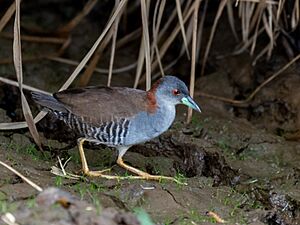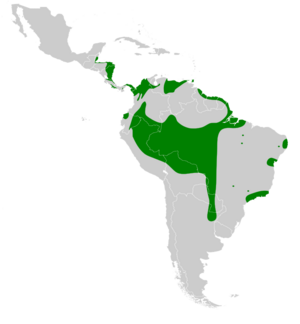Grey-breasted crake facts for kids
Quick facts for kids Grey-breasted crake |
|
|---|---|
 |
|
| Conservation status | |
| Scientific classification | |
| Genus: |
Laterallus
|
| Species: |
exilis
|
 |
|
The grey-breasted crake (Laterallus exilis) is a small, shy bird. It belongs to the Rallidae family. This family includes birds like rails, gallinules, and coots. You can find this crake in many places. It lives in Central America, including Belize and Panama. It also lives across most of South America. The only mainland countries it doesn't live in are Chile and Uruguay. You can also find it on the islands of Trinidad and Tobago.
Contents
About Its Family Tree
This section is about how scientists classify the grey-breasted crake. It's like finding its spot in the bird family tree. The grey-breasted crake is a "monotypic" species. This means there are no different types or subspecies of this bird. Even though some thought there might be a different type near the Honduras-Nicaragua border, it was decided there wasn't.
What Does It Look Like?
The grey-breasted crake is a small bird. It measures about 14 to 15.5 centimeters (5.5 to 6.1 inches) long. Male crakes weigh between 26.5 to 39 grams (0.93 to 1.4 ounces). Females are a bit heavier, weighing 29 to 43 grams (1.0 to 1.5 ounces). Both male and female crakes look very similar.
Adult crakes have a light gray head and chest. Their throat is white. They have a reddish-brown patch on the back of their neck. The rest of their upper body is olive brown. Their sides have strong black and white stripes.
Where It Lives and Its Home
The grey-breasted crake lives in several separate areas. One area stretches from Belize and eastern Guatemala. It goes through Honduras, Nicaragua, Costa Rica, and Panama. It then continues into Colombia and western Venezuela. Another area is in central Venezuela. A third area covers the Guianas and reaches into Brazil.
The largest area where it lives covers most of the Amazon rainforest. This includes parts of Brazil, Colombia, Ecuador, and Bolivia. It also goes south through Paraguay into northeastern Argentina. You can also find it in northwestern Ecuador. There are also a few small areas along the coast of southeastern Brazil. And, as mentioned, it lives on the island of Trinidad.
These crakes live in many different kinds of places. Most of their homes have shallow standing water. This includes the edges of marshes, rivers, and lakes. They also like wet meadows and rice fields. Sometimes, they can even be found in dry places. These might be pastures or airfields.
How It Behaves
Movement
Scientists believe the grey-breasted crake usually stays in one place. It doesn't travel far. However, some local movements are thought to happen. This means they might move short distances within their home area.
What It Eats
We don't know exactly how the grey-breasted crake finds its food. But we do know what it eats. Its diet is mostly insects. It eats many different kinds of bugs. It also enjoys spiders, worms, and seeds.
Reproduction and Life Cycle
The breeding seasons for the grey-breasted crake are not always clear. They seem to change depending on where the bird lives. This bird builds a round nest. It weaves grass and plant stems together. The nest has an opening on the side. Usually, a female crake lays three eggs in her nest.
Its Calls
The grey-breasted crake makes several different sounds. One call is a series of 2 to 10 "tink" or "keek" notes. It also makes a musical rattling sound that goes down in pitch. Sometimes, it makes a quiet, sharp "check" sound.
Its Conservation Status
The IUCN (International Union for Conservation of Nature) has looked at the grey-breasted crake. They have assessed it as a species of "Least Concern." This means it is not currently in danger of disappearing. It lives across a very large area. Scientists estimate there are at least 50,000 adult birds.
However, the number of these birds is thought to be going down. But no immediate threats have been found. The grey-breasted crake is common in the Amazon region. But in Central America, it is found only in certain places and is not very common.


